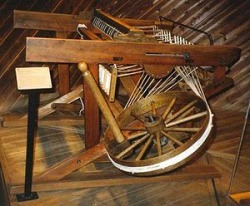Components

The idea was developed as a wooden frame with eight wooden spindles at one end. A set of eight rovings were attached to a beam on that frame. The rovings when extended passed through two horizontal bars of wood that could be clasped together. These bars could be drawn along the top of the frame by the spinners left hand thus extending the thread. The spinner used his right hand to rapidly turn a wheel which caused all the spindles to revolve, and the thread to be spun. When the bars were returned the thread wound onto the spindle. A pressing wire (faller) was used to guide the threads onto the right place on the spindle.[2]
History of weaving
Ideas for ways of automating tasks have been in existence since the time of the ancient Greeks. The Greek inventor Hero (fl. about A.D. 50), for example, is credited with having developed an automated system that would open a temple door when a priest lit a fire on the temple altar. The real impetus for the development of automation came, however, during the Industrial Revolution of the early eighteenth century. Many of the steam-powered devices built by James Watt, Richard Trevithick, Richard Arkwright, Thomas Savery, Thomas Newcomen, and their contemporaries were simple examples of machines capable of taking over the work of humans. One of the most elaborate examples of automated machinery developed during this period was the drawloom designed by the French inventor Basile Bouchon in 1725. The instructions for the operation of the Bouchon loom were recorded on sheets of paper in the form of holes. The needles that carried thread through the loom to make cloth were guided by the presence or absence of those holes. The manual process of weaving a pattern into a piece of cloth through the work of an individual was transformed by the Bouchon process into an operation that could be performed mindlessly by merely stepping on a pedal.
Read more: http://science.jrank.org/pages/674/Automation-History.html#ixzz0TN8gJfQK
Read more: http://science.jrank.org/pages/674/Automation-History.html#ixzz0TN8gJfQK
